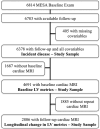Histamine H2 Receptor Antagonists, Left Ventricular Morphology, and Heart Failure Risk: The MESA Study
- PMID: 27150686
- PMCID: PMC4860615
- DOI: 10.1016/j.jacc.2016.01.045
Histamine H2 Receptor Antagonists, Left Ventricular Morphology, and Heart Failure Risk: The MESA Study
Abstract
Background: Myocardial H2 receptor activation may promote cardiac fibrosis and apoptosis in pre-clinical models and histamine H2 receptor antagonist (H2RA) use may improve symptoms in participants with heart failure (HF); however, relationships between H2RA use, incident HF, and longitudinal change in left ventricular (LV) morphology are not known.
Objectives: This study sought to determine whether H2RA use is associated with incident HF and change in LV morphology over time.
Methods: We included 6,378 men and women from MESA (Multi-Ethnic Study of Atherosclerosis), a multicenter prospective observational cohort of participants without cardiovascular disease at baseline. Cox proportional hazards were used to estimate the association between H2RA use and incident HF in adjusted models. In participants with cardiac magnetic resonance imaging, associations between H2RA use, baseline LV morphology (n = 4,691), and longitudinal change in the LV (n = 2,806) were estimated using linear regression.
Results: H2RAs were used by 313 participants but not by the other 6,065 individuals. During a median follow-up of 11.2 years, 236 participants developed HF. In adjusted models, baseline H2RA use relative to nonuse was associated with 62% lower risk for incident HF (p = 0.02). H2RA use was associated with preserved stroke volume, LV end-diastolic volume, and mass/volume ratio as measured by cardiac magnetic resonance imaging over approximately 10 years (all p < 0.05). There were no associations between H2RA use and LV mass or ejection fraction.
Conclusions: H2RA use was associated with reduced risk for incident HF. Left heart morphology over time suggests less age-related change in H2RA users. These associations suggest histamine signaling may be important in the pathogenesis of HF. (Multi-Ethnic Study of Atherosclerosis [MESA]; NCT00005487).
Keywords: cardiac magnetic resonance imaging; heart failure; prevention.
Copyright © 2016 American College of Cardiology Foundation. Published by Elsevier Inc. All rights reserved.
Conflict of interest statement
Figures



Comment in
-
Clinical Evidence of the Role of Histamine in Heart Failure.J Am Coll Cardiol. 2016 Apr 5;67(13):1553-1555. doi: 10.1016/j.jacc.2016.01.046. J Am Coll Cardiol. 2016. PMID: 27150687 No abstract available.
-
Histamine H2 Receptors and Heart Failure: A Complex Cross-Talk.J Am Coll Cardiol. 2016 Aug 16;68(7):774-5. doi: 10.1016/j.jacc.2016.04.065. J Am Coll Cardiol. 2016. PMID: 27515343 No abstract available.
-
Reply: Histamine H2 Receptors and Heart Failure: A Complex Cross-Talk.J Am Coll Cardiol. 2016 Aug 16;68(7):775-6. doi: 10.1016/j.jacc.2016.05.064. J Am Coll Cardiol. 2016. PMID: 27515344 No abstract available.
-
Reply: Is Histamine H2 Receptor a Real Promising Target for Prevention or Treatment of Heart Failure?J Am Coll Cardiol. 2016 Nov 1;68(18):2029-2030. doi: 10.1016/j.jacc.2016.07.774. J Am Coll Cardiol. 2016. PMID: 27788859 No abstract available.
-
Is Histamine H2 Receptor a Real Promising Target for Prevention or Treatment of Heart Failure?J Am Coll Cardiol. 2016 Nov 1;68(18):2029. doi: 10.1016/j.jacc.2016.06.078. J Am Coll Cardiol. 2016. PMID: 27788860 No abstract available.
References
-
- Jacobson BC, Ferris TG, Shea TL, et al. Who is using chronic acid suppression therapy and why? Am J Gastroenterol. 2003;98:51–8. - PubMed
-
- Bristow MR, Ginsburg R, Harrison DC. Histamine and the human heart: the other receptor system. Am J Cardiol. 1982;49:249–51. - PubMed
-
- Matsuda N, Jesmin S, Takahashi Y, et al. Histamine H1 and H2 receptor gene and protein levels are differentially expressed in the hearts of rodents and humans. J Pharmacol Exp Ther. 2004;309:786–95. - PubMed
-
- Bristow MR, Minobe WA, Billingham ME, et al. Anthracycline-associated cardiac and renal damage in rabbits. Evidence for mediation by vasoactive substances. Lab Invest. 1981;45:157–68. - PubMed
-
- Bristow MR, Kantrowitz NE, Harrison WD, Minobe WA, Sageman WS, Billingham ME. Mediation of subacute anthracycline cardiotoxicity in rabbits by cardiac histamine release. J Cardiovasc Pharmacol. 1983;5:913–9. - PubMed
Publication types
MeSH terms
Substances
Associated data
Grants and funding
- N01 HC095161/HL/NHLBI NIH HHS/United States
- N01 HC095168/HL/NHLBI NIH HHS/United States
- N01 HC095167/HC/NHLBI NIH HHS/United States
- N01 HC095161/HC/NHLBI NIH HHS/United States
- N01 HC095164/HC/NHLBI NIH HHS/United States
- N01 HC095167/HL/NHLBI NIH HHS/United States
- N01 HC095160/HC/NHLBI NIH HHS/United States
- N01 HC095159/HL/NHLBI NIH HHS/United States
- N01 HC095163/HL/NHLBI NIH HHS/United States
- N01 HC095165/HC/NHLBI NIH HHS/United States
- KL2 TR002317/TR/NCATS NIH HHS/United States
- N01 HC095168/HC/NHLBI NIH HHS/United States
- UL1 TR000040/TR/NCATS NIH HHS/United States
- N01 HC095162/HL/NHLBI NIH HHS/United States
- UL1 TR001079/TR/NCATS NIH HHS/United States
- N01 HC095169/HL/NHLBI NIH HHS/United States
- N01 HC095166/HL/NHLBI NIH HHS/United States
- KL2 TR000421/TR/NCATS NIH HHS/United States
- N01 HC095163/HC/NHLBI NIH HHS/United States
- N01 HC095162/HC/NHLBI NIH HHS/United States
- N01 HC095165/HL/NHLBI NIH HHS/United States
- K24 HL103844/HL/NHLBI NIH HHS/United States
- N01 HC095164/HL/NHLBI NIH HHS/United States
- N01 HC095159/HC/NHLBI NIH HHS/United States
- N01 HC095160/HL/NHLBI NIH HHS/United States
LinkOut - more resources
Full Text Sources
Other Literature Sources
Medical
Research Materials
Miscellaneous

